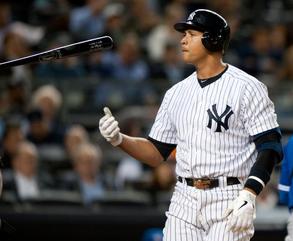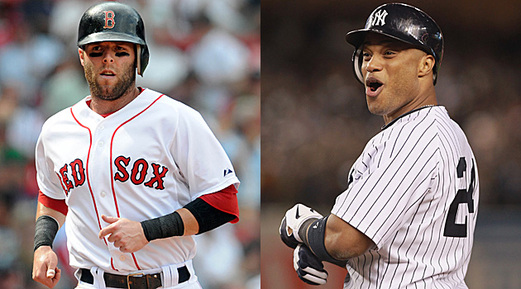
The season wasn't supposed to end this way. The Yankees finished the season with the best record in the American League, most home runs hit, second most runs scored, and had 53 years of postseason experience in their starting lineup alone. Anything short of their 28th World Series Championship would be considered a failure, and regarded by many as the favorite to win the fall classic. They had All-Stars Derek Jeter , Robinson Cano, Curtis Granderson, and CC Sabathia. Hiroki Kuroda won 16 games and had a solid 126 ERA+, while the bullpen included Rafael Soriano (42 SV, 2.26 ERA) and David Robertson (12 K/9, 157 ERA+) After all, they were the New York freaking Yankees, the most storied franchise in all of sports. They had momentum (finished season on 13-4 run) Yet, a season that began with lofty expectations and in complete disaster, following an embarrassing sweep at the hands of the Detroit Tigers.
The Yankees cruised into the playoffs finishing the final month 19-9 with contributers such as Robinson Cano (.593/.600/1.074) and Curtis Granderson (.333/.393/750) red-hot over the final week. Since they had the best record in the league and won the division, the Bombers would also be exempt from the sudden-death Wild Card Game and have "home-field advantage" throughout the playoffs. After a Orioles victory in the Wild Card game, the Yankees would be playing the intra-divisional rival whom they were an even 9-9 during the regular season. An exciting number of close games, peppered with heroic performances (Raaaauuuul!), took the Yankees to a deciding game 5 which saw a dominant C.C. Sabathia take the Yankees to the ALCS. A series in which the Yankees as a team only batted .211/.278/.333 could have provided some apprehension towards future success but could the Yankees talented offense remain ice-cold. After all, they had the most runs scored, home runs, on base percentage, slugging percentage in the league. No way the mighty Yankees would futile in the batter's box for another series…
Well, not only did they stay frigid with the bat, but the Yankees took a bad offensive performance and made it historic. The Yankees had the worst batting average (.188) in a single postseason, Robinson Cano's 0-29 stretch was the longest in postseason history, and only scored one of their six runs prior to the ninth inning. Furthermore, Quentin Berry (yes, Quentin Berry) had a higher OPS (.625) than all but four Yankees. Additionally, the staff was not that great as New York pitchers combined for a 4.14 ERA. Clearly, the Yankees just fell apart this series and were overmatched especially at the plate. Big names such as Robinson Cano , Nick Swisher , Alex Rodriguez , Mark Teixeira , and even Raul Ibanez all batted below .250. Also, it's not just that they slumped but the fact that they were the best offense in the American League and frankly because they have the highest payroll in the league. Teams with $209 million payrolls and that kind of talent are not supposed to flounder in October, no matter how good the opponent is. No doubt, credit should go to Detroit, as their pitchers (minus Jose Valverde ) only allowed 2 runs in the entire series and hitters combined for an .802 OPS. They were another talented team that vastly underperformed (rather, in the regular season) and had a mountain of payroll and expectations coming into the season. Nevertheless, the pathetic showing by the Yankees cannot be explained by much other than the fact that their offense did not show up, clear and simple.
After an embarrassing postseason, the Yankees will face a series of decisions this offseason. Nick Swisher, Russell Martin, Hiroki Kuroda, Andy Pettitte, Mariano Rivera, Ichiro Suzuki and Raul Ibanez are all free agents. Most likely is that Swisher will leave for a long-term commitment, depriving the team of a good OBP source and their starting RF. Theoretically, if Ichiro is resigned, the Yankees can go Brett Gardner in LF, Granderson in CF, and Ichiro in RF. I could definitely see the Yankees going this path considering Ichiro's success in pinstripes without having to pay the big bucks for Swisher's services. Also, Rafael Soriano possesses an opt-out clause to become a free agent. Presumably, Soriano will take this in order to obtain more years at a premium price. Additionally, it seems fairly reasonable that Pettitte, Rivera, and Kuroda will be back due to their desire to stay in the Bronx. Other than some minor moves for bench and bullpen players, the Yankees do not have any glaring holes to be filled.
However, one major concern is the aging of the team. The Yankees will have 0! position players under 30, barring a offseason move. This aging, although it may not have been clearly visible yet, should result in a gradual attrition of their ability to hit and play the field on an everyday basis. Alex Rodriguez has already showed signs of slowing down in his own miserable postseason (have fun with another 5 years $114 million Yankees fans) as well as Mark Teixeira. Robinson Cano will play next season at age 30 and will command a long-term commitment upwards of 6-7 years. And despite his defensive shortcomings, Derek Jeter cannot keep producing offensively, right? Brain Cashman and the front office must add youth to this team sooner rather than later. Even the Yankees have to restock on talent at some point.
Personally, this is how I would fix the Yankees and their age issue. First, I would trade Alex Rodriguez to anyone who wants him and absorb the majority of his contract so that the team could obtain better prospects. Second, I would not extend Robinson Cano to a long term contract. He will be entering his post-prime and although he has had no injury history to this point, second basemen have a tendency to break down rapidly following their age 30-32 seasons (see Utley, Chase). Lastly I would trade Mark Teixeira and eat most of his contract so once again, better prospects could be sent back to New York. Although, the Yankees still have a ton of talent, their offensive struggles highlighted a growing concern about the team's age and its ability to hold up over a full season. This is something needed to be addressed over the next season, or else the Yankees, although equipped with the most financial freedom in the game, will have a rude awakening
The Yankees cruised into the playoffs finishing the final month 19-9 with contributers such as Robinson Cano (.593/.600/1.074) and Curtis Granderson (.333/.393/750) red-hot over the final week. Since they had the best record in the league and won the division, the Bombers would also be exempt from the sudden-death Wild Card Game and have "home-field advantage" throughout the playoffs. After a Orioles victory in the Wild Card game, the Yankees would be playing the intra-divisional rival whom they were an even 9-9 during the regular season. An exciting number of close games, peppered with heroic performances (Raaaauuuul!), took the Yankees to a deciding game 5 which saw a dominant C.C. Sabathia take the Yankees to the ALCS. A series in which the Yankees as a team only batted .211/.278/.333 could have provided some apprehension towards future success but could the Yankees talented offense remain ice-cold. After all, they had the most runs scored, home runs, on base percentage, slugging percentage in the league. No way the mighty Yankees would futile in the batter's box for another series…
Well, not only did they stay frigid with the bat, but the Yankees took a bad offensive performance and made it historic. The Yankees had the worst batting average (.188) in a single postseason, Robinson Cano's 0-29 stretch was the longest in postseason history, and only scored one of their six runs prior to the ninth inning. Furthermore, Quentin Berry (yes, Quentin Berry) had a higher OPS (.625) than all but four Yankees. Additionally, the staff was not that great as New York pitchers combined for a 4.14 ERA. Clearly, the Yankees just fell apart this series and were overmatched especially at the plate. Big names such as Robinson Cano , Nick Swisher , Alex Rodriguez , Mark Teixeira , and even Raul Ibanez all batted below .250. Also, it's not just that they slumped but the fact that they were the best offense in the American League and frankly because they have the highest payroll in the league. Teams with $209 million payrolls and that kind of talent are not supposed to flounder in October, no matter how good the opponent is. No doubt, credit should go to Detroit, as their pitchers (minus Jose Valverde ) only allowed 2 runs in the entire series and hitters combined for an .802 OPS. They were another talented team that vastly underperformed (rather, in the regular season) and had a mountain of payroll and expectations coming into the season. Nevertheless, the pathetic showing by the Yankees cannot be explained by much other than the fact that their offense did not show up, clear and simple.
After an embarrassing postseason, the Yankees will face a series of decisions this offseason. Nick Swisher, Russell Martin, Hiroki Kuroda, Andy Pettitte, Mariano Rivera, Ichiro Suzuki and Raul Ibanez are all free agents. Most likely is that Swisher will leave for a long-term commitment, depriving the team of a good OBP source and their starting RF. Theoretically, if Ichiro is resigned, the Yankees can go Brett Gardner in LF, Granderson in CF, and Ichiro in RF. I could definitely see the Yankees going this path considering Ichiro's success in pinstripes without having to pay the big bucks for Swisher's services. Also, Rafael Soriano possesses an opt-out clause to become a free agent. Presumably, Soriano will take this in order to obtain more years at a premium price. Additionally, it seems fairly reasonable that Pettitte, Rivera, and Kuroda will be back due to their desire to stay in the Bronx. Other than some minor moves for bench and bullpen players, the Yankees do not have any glaring holes to be filled.
However, one major concern is the aging of the team. The Yankees will have 0! position players under 30, barring a offseason move. This aging, although it may not have been clearly visible yet, should result in a gradual attrition of their ability to hit and play the field on an everyday basis. Alex Rodriguez has already showed signs of slowing down in his own miserable postseason (have fun with another 5 years $114 million Yankees fans) as well as Mark Teixeira. Robinson Cano will play next season at age 30 and will command a long-term commitment upwards of 6-7 years. And despite his defensive shortcomings, Derek Jeter cannot keep producing offensively, right? Brain Cashman and the front office must add youth to this team sooner rather than later. Even the Yankees have to restock on talent at some point.
Personally, this is how I would fix the Yankees and their age issue. First, I would trade Alex Rodriguez to anyone who wants him and absorb the majority of his contract so that the team could obtain better prospects. Second, I would not extend Robinson Cano to a long term contract. He will be entering his post-prime and although he has had no injury history to this point, second basemen have a tendency to break down rapidly following their age 30-32 seasons (see Utley, Chase). Lastly I would trade Mark Teixeira and eat most of his contract so once again, better prospects could be sent back to New York. Although, the Yankees still have a ton of talent, their offensive struggles highlighted a growing concern about the team's age and its ability to hold up over a full season. This is something needed to be addressed over the next season, or else the Yankees, although equipped with the most financial freedom in the game, will have a rude awakening

 RSS Feed
RSS Feed